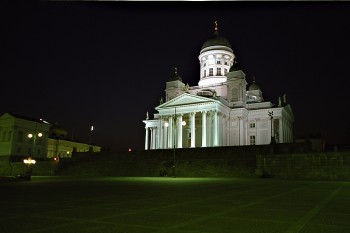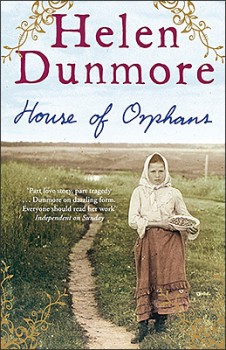Search results for "Что такое нейролингвистическое воздействие больше в insta---batmanapollo"
On the make
31 December 2007 | Fiction, Prose
Extracts from the novel Benjamin Kivi (WSOY, 2007). Introduction by Lauri Sihvonen
Benjamin Kivi alias Into Penger, the 1930s
What was Kuihkä worth? What were this little man and his sons worth? What was I worth?
I drove where the little man told me to, with no lights, through a densely populated area. I could only see half a meter in front of me, trying to sense the bends and curves in the road and still keep Tallus’ car in good shape. When we got to the woods I turned on the lights and glanced at the little man sitting next to me. He was stuffing a handkerchief into his sleeve like an old housewife. The top of his head was sweating. He brushed his hair back and shoved his cap down on his head.
I had two hours to think as I drove, but it felt like a few minutes. If I didn’t drive the car, someone else would have, everything would happen just like the little man had planned, and I wouldn’t know anything about Kuihkä. What was I going to do, watch while he was thrown to the wolves? Kuihkä rescued me once. Was it meant to be that I should drive the car? Was I meant to change the course of events? How many coincidences can there be in one lifetime, and what do they signify? If events weren’t random, then what the hell was I supposed to do? More…
One-night stand: an interview with publisher Leevi Lehto
17 September 2010 | Interviews
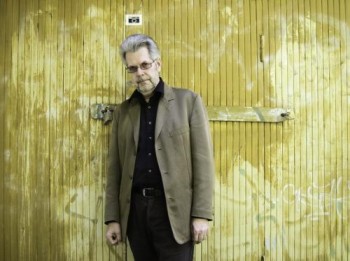
Leevi Lehto. Photo: Lotta Djupsund/Savukeidas
Founded by poet Leevi Lehto, ntamo is seen by many as the black sheep and enfant terrible of the world of Finnish publishing.
From its inception, ntamo (shortened from the word kustantamo, publishing company) has striven to subvert the familiar conservative models of publishing that audiences are used to.
Ntamo publishes books for small circulation, such as poetry and experimental prose. Its catalogue includes works both by celebrated writers, such as Kari Aronpuro, and by a whole host of authors making their literary debuts.
Lehto’s objective has been to publish as many books as possible, using a system of print on demand, and to have as little to do with the books’ content as possible. What’s more, ntamo’s publications are not marketed at all. Readers can find information on new publications by following the publisher’s blog [in Finnish only]. I met up with Lehto a while ago and we discussed ntamo’s current situation, new trends in the publishing world and the future of books and literature in general. More…
Beating the winter blues
8 January 2010 | This 'n' that
We’ve passed the solstice, so in principle the days are getting longer; but as we drag ourselves back into the office after the holidays, the mornings and evenings still seem pretty gloomy. We’re not complaining; further north, as the radio weather forecast reminds us daily, it’s even darker. Here, sunrise is after nine and sunset before four; further north, in Utsjoki, right up in the Arctic, it set in late November and won’t rise again until 16 January.
Still, even here, any glimmer of light is welcome. All over the city, at this time of year, SADS cafes spring up, with high-intensity light sources to combat seasonal affective disorder or, as we call it in the vernacular, the winter blues. The effect, especially after a couple of hours spent in an editorial board meeting, can be electrifying. More…
Mary Bloom
31 December 1983 | Archives online, Drama, Fiction
Introduction by Väinö Vainio
‘Is Mary Bloom about a revivalist religious meeting, a party political conference at which a new leader is born, or a rock concert? These are among the things that have been suggested. I don’t know. I don’t hope for restraint in the imaginations of those who choose.to interpret my work, although I observe it myself. The work of a writer is a part of life, it is an individual and collective experience that seeks, finds, takes and uses its materials like a motor machine. For those who create it the drama is real, as in the theatre, for the duration of the performance.’ Jussi Kylätasku
Characters
Mary Bloom
Martha, a doctor
Otto, a preacher
Disabled veteran
Serenity, his wife
Alcoholic
Cold Cal, a prisoner
Blind man, Deaf Wife More…
He came in through the bathroom window
30 June 1991 | Archives online, Fiction, Prose
A short story from Utslag och andra noveller (‘Rash and other stories’, Alba, 1989). Introduction by Pekka Tarkka
He heard a voice behind him:
‘Hey, Aspelin, what are you doing here?’
Awakening from a half-sleep, he looked around as Ilpo approached his seat.
‘I work near here. I’m teaching math to the visually impaired.’
Ilpo sat down next to him. For several seconds they sat without speaking. Then Aspelin collected himself.
‘And you?’
‘Visiting a friend. He lives in Mäkkylä.’ More…
Finland, cool! The Frankfurt Book Fair 8–12 October
30 September 2014 | Articles, Non-fiction

Finnland. Cool. pavilion in Frankfurt, designed by Natalia Baczynska Kimberley, Nina Kosonen and Matti Mikkilä from Aalto University
It starts next week: Finland is Guest of Honour at the Book Fair in the German and global city of Frankfurt. This link will take you to it all.
Approximately 170,000 professionals from the literary world are expected to visit the exhibition halls from Wednesday to Friday; the weekend is reserved for the general public, c.100,000 visitors. Since 1980s different countries have been in focus each year. More…
Fiat lux! Helsinki lit
9 January 2014 | This 'n' that
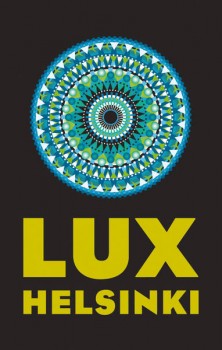 When there’s no snow in January, as is the case this year, the darkness does make Helsinki appear somewhat joyless. This year Canada and parts of the United States got more than a taste of freezing Arctic temperatures – but at the time of writing winter is still postponed in the lower half of Finland.
When there’s no snow in January, as is the case this year, the darkness does make Helsinki appear somewhat joyless. This year Canada and parts of the United States got more than a taste of freezing Arctic temperatures – but at the time of writing winter is still postponed in the lower half of Finland.
A temporary relief was brought by Lux Helsinki – staged now for the sixth time – as light, colour and sound made the capital brighter and more beautiful between 4 and 8 January.
The core of the city, the Cathedral, was adorned by a large heart placed at the top of the steps, beating in colours to music.

Corazón by Agatha Ruiz de la Prada. Photo: Marina Okras
Corazón, by the Madrid-born artist and fashion designer Agatha Ruiz de la Prada, in collaboration with the production and design company D-Facto, reflects her design themes of love and happiness.
One of the participants in Lux Helsinki was Unen ääret / Edges of Dreams: projected on to the façade of the Hakasalmi Villa (1843–46), between the Finlandia Hall and the Music House, it was inspired by the history of the building and its inhabitants. Now a museum, it became known as the home of a benefactor of the city, a rich and famous woman of her time, Aurora Karamzin from the 1860s to the 1890s.
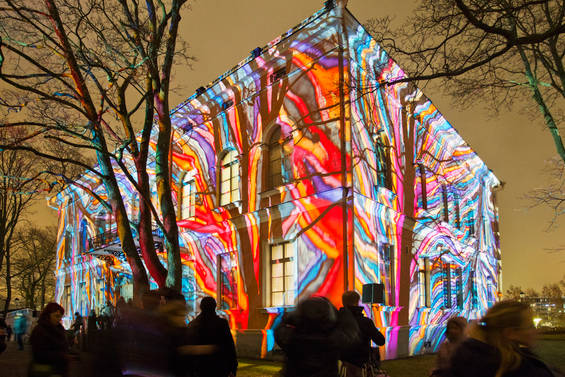
Hakasalmi Villa: Edges of Dreams by Mika Haaranen. Photo: Lauri Rotko
The building was seen through dreamlike visions formed by painted films and shadow patterns by Mika Haaranen, a lighting and set designer and photographer. His works extend from the world of theatre and musicals to contemporary dance, concerts and film. The accompanying music was composed by Aake Otsala.
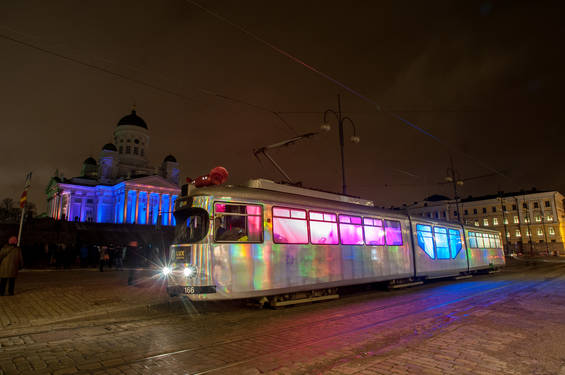
Lux Tram by students of lighting and sound design, Theatre Academy. Photo: Hannu Iso-Oja
Helsinki trams have been transporting citizens from 1891. One of the trams was transformed into a moving light installation by the use of programmable LED floodlights. The work was designed and realised by the Theatre Academy of the University of the Arts Helsinki lighting design students Riikka Karjalainen and Alexander Salvesen. A pity it was not possible to hop on…
Plain sailing
31 March 1996 | Archives online, Fiction, Prose
An extract from Alastalon salissa (‘In Alastalo’s parlour’, 1933). Introduction by Kai Laitinen
A letter from the translator:
Dear Editors,
Reluctantly (I really have tried) I have been driven to conclude that Alastalon salissa is untranslatable, except perhaps by a fanatical Volter Kilpi enthusiast who is prepared to devote a lifetime to it. To mention only one of the difficulties, there is no English equivalent to the style of the Finnish ‘proverbs’ (real or imaginary) with which the main character Alastalo’s thoughts are so thickly larded. Add to this the richness and, yes, eccentricity, of Kilpi’s vocabulary, and the unfamiliarity of much of the subject-matter, centred as it is on the interests of a sea going community that hardly exists any longer, even on the islands, and you have a text that is full of pitfalls for the translator. As for the humour, I’m sorry to say that it depends so much on the idiom and presentation that it doesn’t come over at all. If I did any more, I’m afraid it would just have to be a laborious paraphrase, and I don’t think I’m capable of making it effective, or even readable, in English.
Apart from that, although I’m very grateful for your explanations of the many unfamiliar words and phrases, I’m very unwilling to commit myself to the translation of any of them on the basis of a mere ‘gloss’ (technical word): I need to know the associations, and possible sound-echoes, of every one of them before I can be sure of getting it right. And getting it right affects the rhythm of every sentence: it’s not just a matter of filling in blanks with ‘equivalents’ provided by someone else.
I’ve no objection to your using my version of the opening pages. If you decide to follow it with some kind of comment, do borrow, if you need to, from my remarks above, giving the translator’s point of view. Sorry to have failed you so badly.
Yours, David Barrett More…
Positive fools
1 April 2010 | This 'n' that
‘People who think about what others think of them are above all afraid of being ridiculed. Consider it an irony of fate or not, but the Finns in literature are usually laughable in some way or other,’ Janna Kantola – lecturer in Comparative Literature in Helsinki University – writes in an article entitled ‘Strong, thirsty and weird’, published in the 6/2009 issue of the Helsinki University Bulletin.
Mostly they drink and end up on the wrong side of the law. For example, there are Finnish seafarers in fiction by European writers whose rum bottles apparently have no bottoms.
‘Finland and the Finns appear, in particular, in thrillers from the Cold War: from Raymond Chandler’s The Long Goodbye (1953) to Alistair MacLean’s novel HMS Ulysses (1955). In these works, the unsmiling and hulking Finns have wide, horny hands, massive bottoms and the strength of a hundred men.
‘But not to worry. On a couple of occasions, Finns have even got to be the main characters of books. In these instances, the Finns no longer make people laugh but are mostly tragic, just as the characters in literature usually are when they are most interesting.
‘The main character in Richard Rayner’s novel The Cloud Sketcher (2000, USA) is an architect – a popular profession for Finns in modern literature – who has a disfigured face and a hard history, reaching America by way of the Finnish civil war. The historical novel by Helen Dunmore, House of Orphans (2006, UK), set in Finland in 1901–1904, is a love story about two young rebels, Eeva and Lauri.
One of the success stories of Finnish literature abroad are the humorous novels by Arto Paasilinna (born 1942): they have been translated into almost 40 languages. ‘Through his books Arto Paasilinna has turned being a fool into a positive characteristic. All things considered, this is something Finland will have no shortage in offering,’ Kantola concludes.
Irma-Riitta Järvinen: Kalevala Guide
10 September 2010 | Mini reviews, Reviews
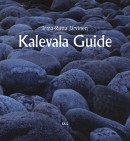 Kalevala Guide
Kalevala Guide
Helsinki: Finnish Literature Society, 2010. 127 p., ill.
ISBN 978-952-222-193-3
€ 24.90, paperback
This book is a brief but comprehensive English-language guide to the Finnish national epic, which was based on the archaic oral, sung folk poetry of Karelia, but collected and personally compiled by the scholar and writer Elias Lönnrot (1802–1884). The epic (first edition 1839, complemented in 1849) is set in a mythic past; technically speaking, the metre is an unrhymed, non-strophic trochaic tetrametre, characterised by alliteration. Contents, characters, places and themes are explained in the Guide, which also explores myths of origin and the significance of the epic. On his eleven trips to Archangel and North Karelia, Lönnrot met some 70 singers. The Kalevala, now translated, at least in part, into more than 60 languages, has inspired artists the world over (J.R.R. Tolkien was a fan, while Henry Wadsworth Longfellow’s Hiawatha imitates the metre and style of the Kalevala). The composer Jean Sibelius and the artist Akseli Gallen-Kallela are perhaps the best known Finnish Kalevala artists. And the inspiration continues: for instance, rock musicians and visual artists make use of Kalevala themes, stories and characters in their work. The book includes a list of relevant websites and a select bibliography.
Location, location, location
11 February 2013 | Articles, Non-fiction
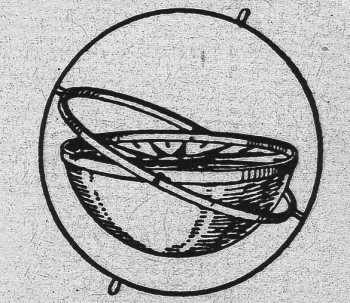
Before GPS: compass and and gimbal, 1570. Picture: Wikimedia
Art that requires navigation systems? Whatever next. In his column poet and writer Teemu Manninen wonders whether literature can function as ‘locative’. How to blend technology and art? Perhaps literature too might expand from the printed word
What if the Romantic poet John Keats had never published his poetry in print – if his works had been distributed only in manuscript form and read only by his friends and acquaintances? Had that been the case, the only way of hearing his poetry would have been at the salons and informal clubs that took place in literary people’s homes, at coffee houses, or other meeting places.
Keats might not even have, most likely, been in attendance himself, but maybe someone had a copy of a copy of a fragment of a poem that they might read to the gathered intellectuals and gentlefolk. You would have to have known the right people, have to have been at the right place at the right time to hear ‘Ode to a Nightingale’ read for the first and perhaps for the last time ever.
Or, what if Joyce had never intended for Ulysses to be published for the great reading public at all? What if, instead, he had left copies of each chapter around Dublin in the places where those chapters take place; what if, page by page, he had distributed his work in the actual locations of the events as they happened in his imagination? More…
Man and boy
31 December 2006 | Archives online, Fiction, Prose
Extracts from the novel Kansallismaisema (‘National landscape’ Tammi, 2006). Introduction by Tuomas Juntunen
Plans were afoot to establish boys’ camps across the country. This was an experiment, a chance to test the water, to be a pioneer. Here was the opportunity to be the first in line to conquer the Wild West, just as many a brave cowboy had done in years gone by. The Ministry of General Affairs planned to put all 15-year-olds to work for the duration of the summer holidays. Casual labourers were often even younger. Our task was to ascertain a suitable minimum age. In addition, special camps were planned for those not suited to normal work camps. In the summers to come the youth of Finland would be fully employed. Weren’t we in fact driven by the same desire, Tikka had wondered. We both cared about the next generation. We wanted to root out their deficiencies so that they would be able to face life’s challenges to the full. More…

